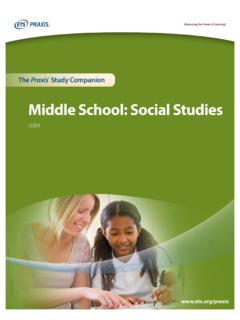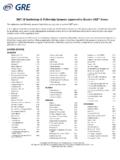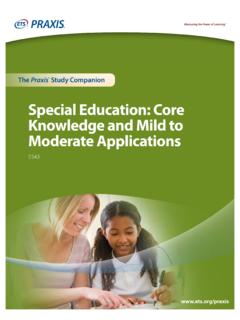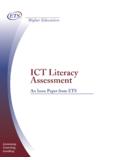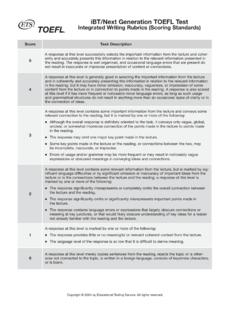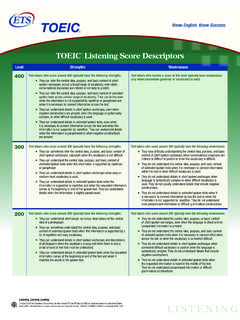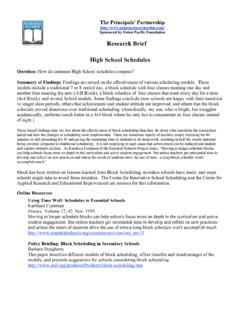Transcription of Dropping Out of High School: Prevalence, Risk Factors, and ...
1 A reader of ETS s R&D Connections, you have doubtless graduated from high school and, more than likely, from college. But what if you had not? In what ways would your life be different? Such questions are of particular interest to us as scientists at ETS s Research and Development division and its Center for Academic and Workforce Readiness and Success. To address the high school dropout problem, educational institutions must identify early on which students are likely to drop out. We are exploring the possibility of working with state boards of education on projects that identify students at risk of Dropping out of high school . This is not only a problem for high schools, but also for colleges and universities. To that end, we have just embarked on a multiyear study to predict dropout rates at Northern Kentucky University.
2 The work on dropouts whether in high school or college supports ETS s mission of advancing quality and equity in Bleak ProspectHigh school dropouts earn $9,200 less per year on average than those who graduate. Over the course of their lifetimes, they will earn an average of $375,000 less than high school graduates, and roughly $1 million less than college graduates (Center for Labor Market Studies, 2007). This income gap has increased over recent years: median earnings of families of high school dropouts were nearly 30% lower in 2004 than they were in 1974 (Achieve, 2006). Furthermore, high school dropouts are three times more likely to be unemployed than college graduates. Chances are also much higher that they will be living in poverty compared to high school graduates (Bridgeland, Dilulio, & Morison, 2006).
3 Given these facts, it is not surprising that those with lower levels of education also tend to be less healthy (Lleras-Muney, 2005). It is not only the individual that suffers economically from Dropping out. Society also pays a price when students fail. Forty percent of 16- to 24-year-old dropouts received some form of government assistance in 2001. And it is estimated that each high school dropout who turns to drugs or crime costs the nation anywhere from $ million to Dropping Out of high school : prevalence , Risk factors , and Remediation StrategiesBy Jeremy Burrus and Richard D. RobertsNo. 18 February 2012 Editor s note: Jeremy Burrus is a research scientist in the Research & Development division, where Richard D. Roberts is a managing principal research scientist. Burrus and Roberts both work at ETS s Center for Academic and Workforce Readiness and Concepts Dropping out To quit a course or school without achieving a diploma.
4 Dropout A student who fails to complete a school or college course. Dropout factories Schools with very poor graduation rates. Theory of Planned Behavior The Theory of Planned Behavior states that the best predictor of behavior is one s intention to perform that behavior. In turn, intentions are determined by attitudes (evaluation of the behavior), subjective norms (social pressure to perform the behavior), and perceived control (one s belief that he or she has the ability to perform the behavior). R&D Connections No. 18 February $ million dollars over his or her lifespan (Bridgeland, 2006). high school dropouts may taken together represent billions of dollars annually in lost revenue for the economy (Achieve, 2006; Christenson & Thurlow, 2004). As an educational assessment organization, ETS can design assessments that predict which students are most at risk for Dropping out.
5 Researchers have, as shown below, identified several factors related to Dropping out of school , and many of these factors can be identified early on in a student s school career. ETS can support this field by providing reliable assessments that measure these factors , thus helping educators identify students in need of intervention while there is still time. Changing Status QuoIt is our hope that our work will help change the dropout status quo, but let us begin by reviewing the current state of affairs. How many young people drop out of high school ? For 2009, the National Center for Education Statistics (NCES) estimates that of all non-incarcerated 16- to 24-year olds in the United States were not enrolled in school and had yet to earn a high school degree (Aud et al., 2011).
6 That adds up to about million people. Furthermore, 40% of all incarcerated 16- to 24-year olds in the United States are high school dropouts, adding an additional 205,000 people to this population. This figure may need to be revised upwards as it does not include a group that NCES s research may not well represent those whose immigration status is undocumented. If we add this group to the total, the number of 16- to 24-year-old dropouts will probably exceed 4 million at any one time. The average graduation rate by state is depicted in Figure 1. Average freshman graduation rate for public high school students, by state or jurisdiction: school year 2007 08 Source: Department of Education. Institute of Education Sciences, National Center for Education Statistics. ETS can design assessments that predict which students are most at risk for Dropping out.
7 Researchers have identified several factors related to Dropping out of school , and many of these factors can be identified early on in a student s school career. Less than (10) (24) or higher (17)R&D Connections No. 18 February dropout numbers for ethnic minorities are considerably higher. In 2009, the proportions of 16- to 24-year-old high school dropouts were for African Americans, for American Indians, and for Hispanics. This problem is exacerbated in urban centers (Neild & Balfanz, 2006). Researchers estimate that as few as 50% of African-American, American Indian, and Hispanic students graduate from high school in some cities (Bridgeland et al., 2006).These are dismal numbers, but we do have reasons to believe that they can be improved. Some of the most compelling reasons for hope come from the dropouts themselves.
8 For instance, Bridgeland et al. (2006) conducted focus groups and face-to-face interviews of a diverse set of 467 dropouts aged 16 to 25 in 25 locations across the United States. Most interviewees believed that they had the ability to earn a high school degree: 70% said they were confident that they could have graduated high school if they had stayed in school , and 66% said they would have worked harder if their teachers and parents had had higher expectations of them. One should take care in interpreting these results, however, as this was not a nationally representative sample. In addition, many respondents were aware of the importance of having a high school diploma. Eighty-one percent of the people interviewed said that getting a high school diploma was essential to their personal success.
9 Furthermore, the great majority of dropouts regretted Dropping out: 74% said they would have stayed in school if they could decide again. In addition, 76% of those who said they regretted their decision to drop out said that they would return to school if that option existed for students in their age group (Bridgeland et al., 2006). These individuals are clearly not lost causes, and there is value in identifying students at risk of Dropping out. If we can reach these students before they drop out and intervene to keep them in school , we can improve the future of both individual students and the nation as a Dropout ProcessDropping out is a process that begins well before high school , and students exhibit identifiable warning signs at least one to three years before they drop out ( , Allensworth, 2005; Neild & Balfanz, 2006; Roderick, 1994; Rumberger, 2004).
10 Furthermore, most students who drop out tend to do so relatively early in their high school careers. One recent study found that most students who dropped out of the Philadelphia public schools did so by the end of the 10th grade (Neild & Balfanz, 2006). Although students in Pennsylvania do not have the legal right to drop out until they are 17 years old, these students are referred to as undercredited, meaning that they have successfully completed relatively few courses compared to the number of years they have spent in school . This means that they have dropped out for all practical purposes even though they are not legally allowed to do it at that age. Furthermore, 70% of Philadelphia students classified as near dropouts, or students who attend class less than 50% of the time, were in the ninth or 10th grade.

